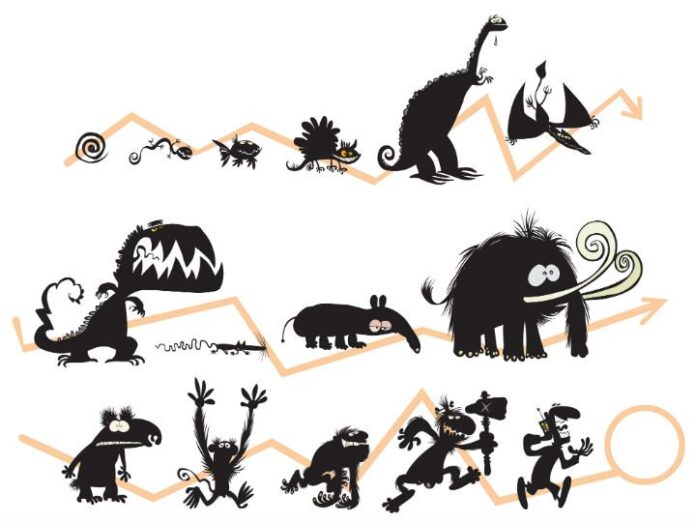WebNMS likens the explosion of IoT to our diverse history
Editor’s Note: With 2016 now upon us, RCR Wireless News has gathered predictions from leading industry analysts and executives on what they expect to see in the new year.
Studying the fossil record, evolutionary biologists have theorized an event called the Cambrian explosion. During a relatively short period, the diversity of animal life seems to have rapidly increased from predominately single-cell organisms to a much wider variety of complex organisms.
In many respects, the “Internet of Things” seems like the evolution of previous telemetry and industrial networking technologies. However, the IoT’s potential to converge our physical and digital worlds justifies its place at or near the top of the hyped technology list. This year, we will witness the beginning of a new era, transformed by a Cambrian-like stage of explosive IoT evolution. During the next two or three years, we expect to experience an IoT transformation with a similar dramatic increase in the diversity of connected things as well as their number.
Stirring the Primordial soup: down-market mobile networks
The explosive growth of the IoT will strain mobile connectivity, not necessarily from a speed-per-device perspective, but from the sheer volume of devices. The large volume will also pressure the devices themselves to be extremely economical. Mobile operators, like Verizon Wireless with their Cat-1 LTE deployments, have already committed to innovation in this area and we should see further aggressive actions by a broader set of providers in 2016. For IoT traffic, new mobile technology innovations will focus on creating a ubiquitous pool of connectivity that allows the simplest, smallest IoT devices to connect with very low radio cost, data usage and power overhead.
Evolutionary branches: diverse connectivity
Device diversity will explode across almost all vertical markets, both consumer and business-to-business. Traditional mobile and landline networks will provide the underlying backbone for cloud connectivity, but the connectivity for each species of device will be specialized for its own environment, causing a corresponding increase in the number of technological connectivity innovations. Bluetooth, ZigBee and LoRa have already emerged, and we can expect further advances to solve problems of scale, density and coverage as the number of devices and their environmental adaptations expand.
Emergence of the social gene: collaborative things
In the past, the IoT ecosystem has tended to be heavily siloed and somewhat rigid. Not only have sensor, gateway and software vendors tended to work individually and develop proprietary applications, but each narrow vertical market has had their own independent supply chain. These silos limited the scope of fluid data exchange and the opportunity for innovation through data analysis and cross-device correlation.
In recent years, many participants in the IoT ecosystem have begun to realize the potential of working together to improve the value of the IoT. A social network of different things will enable previously siloed information to be shared across the end users operational scope, not just within the vertical of its individual suppliers.
This will drive the industry toward open architectures, interfaces and platforms. Similar to the Android ecosystem in the smartphone market, an open approach will create a more efficient technology platform and a more nimble supply chain that quickly adapts to business opportunities.
Survival of the fittest: enterprise investment
In 2016, medium and large enterprises will feel pressure to invest in IoT solutions to remain competitive. Thought leaders, such as GE with its Predix IoT platform, have already established a basic value proposition that applies to nearly every vertical – increasing efficiency and lowering operating costs. Failing to invest in IoT will expose companies to risk from innovation by both current competitors and disruptive market entrants. For example, Uber has captured significant market share in local transportation with vehicle tracking technology and an elegant user interface.
Giant enterprises, like GE, can afford to make large investments in IoT technology and develop platforms of their own. Other, smaller concerns will create applications on IoT software platforms, often hosted in cloud data centers from the same IT vendors. These IT vendors will need to deliver gateway solutions that help aggregate traffic from relatively simple IoT devices.
Gaia ecology: smart cities and sustainable living
Most of the world’s countries have announced smart city projects that apply IoT technology to address key social issues such as sustainability, health and safety, and basic transportation. IoT solutions that target these government-administered projects will also be based on open, multidevice IoT software platforms. In 2016, these applications will break ground in establishing regulations concerning privacy versus information sharing.
In this sphere, the explosive evolution of IoT technology may have the most profound long-term effects on all of our futures. Hopefully, IoT will improve the sustainability of our own society and enable significant improvement in the human condition.
In summary, I expect 2016 to start an exciting growth phase for the IoT market. Like any hyped technology term, “IoT” represents an evolutionary phase of a continuum of technology advancement. Despite this fact, we might look back from the future and label this period of prolific device connectedness innovation as the IoT explosion.
With over 14 years of experience delivering service provider software solutions, Prabhu Ramachandran directs WebNMS, the service provider division of Zoho Corporation. Ramachandran leads strategic marketing, product management, customer support, partnerships and professional services for WebNMS. Leveraging the technology of the corporation’s flagship WebNMS Framework, Ramachandran has expanded the business from its longstanding leadership position in multivendor network and element management software into vertical solutions for carrier Ethernet, MPLS, broadband, LTE and satellite networks. In 2012, Ramachandran began driving WebNMS into network orchestration, SDN, NFV and IoT/M2M platforms, all critical enablers for service providers to grow profitable businesses. He holds a Bachelor’s Degree in Electronics and Communication from Madras University, Chennai, India.
Photo copyright: klibbor / 123RF Stock Photo


